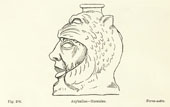Previous First Next
SALAMIS IN THE ISLAND OF CYPRUS.
BY ALEXANDER PALMA DI CESNOLÀ, F.S.A.,
page 120
Phœnicians alone, it seems to me, deserve the credit of making "pots" on which circles are drawn which absolutely  contradict the harmonic principle by existing in upright, instead of horizontal, positions. There are very many specimens of this nature, and they are all defective in respect to grace of contour, the proportions
of the handles, and the positions of the handles where such members occur, as well as in the proportions of the decorative elements to each other, and, above all, to the vessels to which they give a character. Many of these relics exhibit the concentric ring ornament which I have already associated with an Assyrian mode; nevertheless, this does not militate against the reasonableness of the notion which refers these ill-proportioned vessels to the Phœnicians, or, at least, to a predominance of their influence in Cyprus. As a rule, Greek pots were so far "reasonable", that is, logical, in the relationship of their construction and services, that they do not fail to stand on their own bottoms. Unless they were amphorae, and devised to lean against one another, be buried in sand as cisterns, or otherwise serve as fixtures, or be contradict the harmonic principle by existing in upright, instead of horizontal, positions. There are very many specimens of this nature, and they are all defective in respect to grace of contour, the proportions
of the handles, and the positions of the handles where such members occur, as well as in the proportions of the decorative elements to each other, and, above all, to the vessels to which they give a character. Many of these relics exhibit the concentric ring ornament which I have already associated with an Assyrian mode; nevertheless, this does not militate against the reasonableness of the notion which refers these ill-proportioned vessels to the Phœnicians, or, at least, to a predominance of their influence in Cyprus. As a rule, Greek pots were so far "reasonable", that is, logical, in the relationship of their construction and services, that they do not fail to stand on their own bottoms. Unless they were amphorae, and devised to lean against one another, be buried in sand as cisterns, or otherwise serve as fixtures, or be  propped on stands made for the purpose—removableness not being essential in their cases—all the Greek vessels subserve this rule of being capable of standing upright. Now, on the other hand, but a very smallproportion of the so-called Phœnician vessels have the slightest power of standing on their bottoms, for the fact is, they will stand in any other position than the upright one. Those which are furnished ' with base-rings, and are, therefore, enabled to stand upright, have less of the apparently indispensable elementary power of standing on their bottoms. Of course, there are Greek rhyton s which will only rest when inverted; but there was a reason for that odd arrangement, which does not at all affect what I have ventured to suggest. Of late style, reminding one in some respects of the médiǽval bellarmine, I propped on stands made for the purpose—removableness not being essential in their cases—all the Greek vessels subserve this rule of being capable of standing upright. Now, on the other hand, but a very smallproportion of the so-called Phœnician vessels have the slightest power of standing on their bottoms, for the fact is, they will stand in any other position than the upright one. Those which are furnished ' with base-rings, and are, therefore, enabled to stand upright, have less of the apparently indispensable elementary power of standing on their bottoms. Of course, there are Greek rhyton s which will only rest when inverted; but there was a reason for that odd arrangement, which does not at all affect what I have ventured to suggest. Of late style, reminding one in some respects of the médiǽval bellarmine, I discovered a jug (fig. 284) with pyriform body, broad ribbon-shaped handle, and narrow neck. The front of the neck and lip is ornamented in a somewhat unusual manner with the bold relief of a female figure (fig. 285), closelydraped, carrying a fictile vessel of a shape almost identical with the modern pitcher. This may, perhaps, be attributed to the fancy of a potter, rather than to the conventionalism of a type. The vase itself is 1 ft. 6 in. high". The forms which are discovered a jug (fig. 284) with pyriform body, broad ribbon-shaped handle, and narrow neck. The front of the neck and lip is ornamented in a somewhat unusual manner with the bold relief of a female figure (fig. 285), closelydraped, carrying a fictile vessel of a shape almost identical with the modern pitcher. This may, perhaps, be attributed to the fancy of a potter, rather than to the conventionalism of a type. The vase itself is 1 ft. 6 in. high". The forms which are  affected by aryballi are very various. Among others, one in the collection, nicely moulded, takes the form of the head of Hercules (fig. 286), covered with the skin of the lion's head; the ears, nostrils, and teeth of the vanquished animal being clearly shewn (fig. 287). The orifice by affected by aryballi are very various. Among others, one in the collection, nicely moulded, takes the form of the head of Hercules (fig. 286), covered with the skin of the lion's head; the ears, nostrils, and teeth of the vanquished animal being clearly shewn (fig. 287). The orifice by

Previous First Next
|